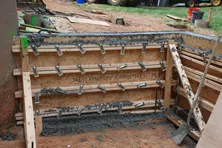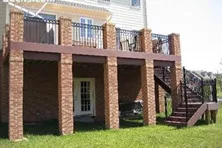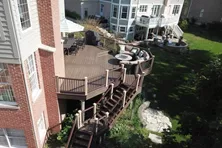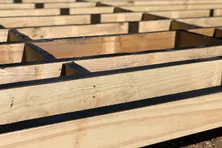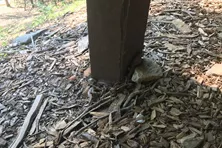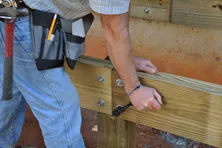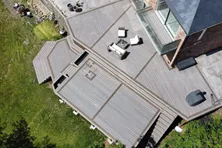Deck Footing Frost Depth Map
Your deck footing depth is controlled by two things. First and foremost, you need to have good soil conditions that can support the concentrated load placed on each deck pier. You then must consult a frost depth map or reach out to your local building inspector to find out how far you need to dig down to get below the frost line depth in your town or city. You may wonder how deep the frost line is. It can vary wildly. In the coldest climates in the USA, the frost depth can be deeper than eight feet. In warmer parts of the country, the frost depth may be less than one foot.
What is the Frost Line?
The frost line is the deepest depth at which the moisture present in the soil is expected to freeze. Once the bottom of your footings is buried below the frost line, the residual heat in the ground below the footing will ensure the soil below the footing will not freeze in the winter.
The depth you are required to set your frost footings will vary from region to region across the country. If you live in a warm climate, like South Florida, where frost rarely ever occurs, you may be allowed to place your footings on grade, but in very cold regions, like Minnesota and Canada, you will need to dig down 96 inches or more. Always check with your local building inspector to see what is required in your area. Furthermore, you must install footings at least 12” below unsettled soil. If you are building into the side of a steep hill or beside a retaining wall you will have to maintain the minimum distance to grade not only vertically but also laterally. In order to achieve a suitable lateral barrier, you may need to dig your foundation much deeper than on a flat surface.
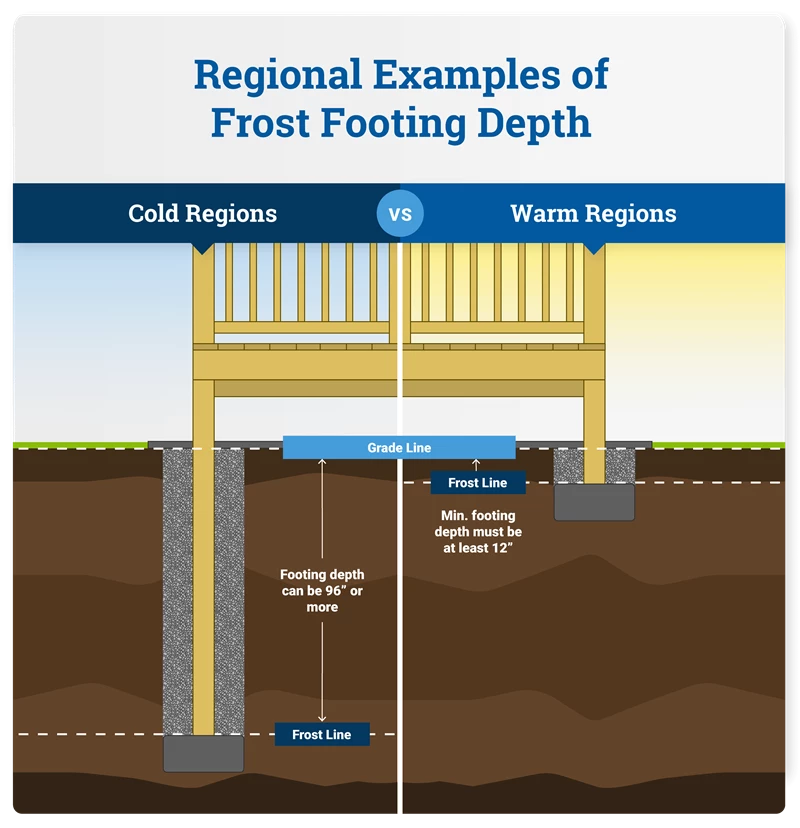
Why is the Frost Line Important in Construction?
When you build any structure, your goal is to ensure the foundation of the structure doesn’t move over time. Just as you don’t want to build on poor soil where the weight of the building will cause unequal downward settling which can destroy the structure, you don’t want the structure or your deck to lift up into the air unequally. Frost heaving can and does lift things up, things that weigh thousands of pounds. Should the soil beneath the footing freeze, the uplift force created by the expanding freezing water can lift the footing and anything on it up into the air. The uplift force is tremendous and can do significant structural damage to your deck.
What Happens When the Soil Freezes?
When below-freezing weather begins, the soil that’s in contact with the air starts to freeze. If the air temperature is well below 32 F, then that soil temperature can easily start to mimic the air temperature. This causes the soil just below the frozen layer at the surface to also freeze.
Liquid water expands by nine percent when it freezes solid. This extra volume is pushed up into the air, not down into the compacted soil.
The liquid water in the soil often is in layers much like a sandwich has layers of meat, cheese, lettuce, and tomato. These different areas of water transform into ice lenses within the soil. As each ice lens forms, it pushes the lenses above it higher up into the air. Frost can easily push the soil up 6, or more, inches.
Frost Depth Map
A frost depth map is a useful tool to give you a rough idea of how deep you need to dig into the soil to get to where the ground rarely freezes. Often, you’ll see contour lines on a frost-depth map where any point along that line represents the frost depth in those towns and cities where the line crosses. These lines are just guidelines and it’s always best to talk with your local building inspector to discover the true frost depth where you’re building.
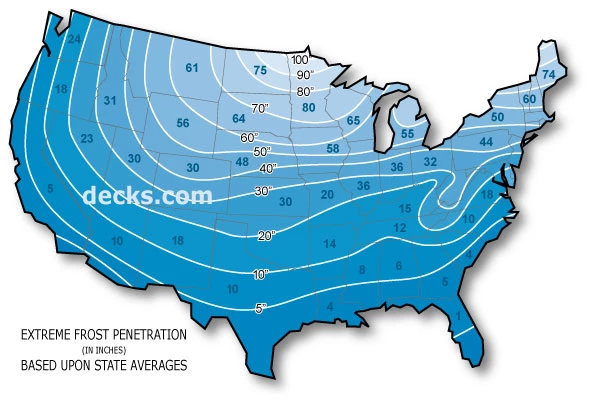
Frost Line Depth by Zip Code
There are online tools that allow you to enter a zip code to discover what the frost depth might be where you’re building. Once again, don’t take this information as gospel. Reach out to the local building inspector for the best guidance. You never want to hope frost won’t hurt your new deck or structure. You should only hope for things you can’t control. You can control the depth of your new deck footings.
Keep in mind it’s not a bad idea to dig three or four inches lower than the frost depth. Deeper is always better because there are rare weather events where extreme cold can happen over a winter and your deck or structure will survive where many others might have to have repairs when the ground thaws.
To find a professional builder in your area, Decks.com also offers a “Find a Builder” tool.
Cutting a Concrete Pad
Learn how to use a concrete saw to cut a hole in a patio slab to install a deck footing.
Retaining Walls
Avoid problems related to digging deck footings near retaining walls. Learn some tips from the pros for how to handle these difficult situations.
Deck Bracing
Learn how to install knee bracing in-between your deck support posts to provide extra strength against high winds and to prevent racking forces for tall decks.
How to Decorate Deck Support Columns
Browse some examples of decorative deck support posts for tall decks.
Deck Joist Cantilever & Overhang Rules
Learn what factors determine the maximum joist cantilever overhang that is allowed.
Why is Joist Protection so Important for Your Deck?
If you’ve ever seen a piece of wood left out in the weather for any period of time, you know what happens: decay. Whether through wet rot, insect damage, or mildew, the fibers begin to break down.
More Helpful Resources
Explore Articles by Topic

Footings
Information related to installing frost footings for decks

Framing
Learn structural framing methods

Decking
Learn about wood and composite decking materials

Stairs
An in-depth look at the complex issue of how to build stairs

Railings
How to install guardrails and handrails to meet IRC code

Features
An overview on water drainage, benches, planters and lights

Design
The basics of deck design

Planning
Learn about permits and working with contractors

Porches & Patios
Build a covered deck to enjoy all seasons

Ledger
Proper attachment techniques

Care
Maintain your deck to maintain your investment

Materials
An overview on water drainage, benches, planters and lights
How many footings do I need?
Learn how to determine the number of footings and support posts you need for your deck when designing your deck frame.
Footing Size
You don’t need to be an engineer to figure out what size footings your new deck will need to safely support it. Everything you need to know is right here.
Can I reuse existing footings
Our inspector discusses the topic of reusing footings for a new deck.
Why is Joist Protection so Important for Your Deck?
If you’ve ever seen a piece of wood left out in the weather for any period of time, you know what happens: decay. Whether through wet rot, insect damage, or mildew, the fibers begin to break down.
How to Build a Freestanding Deck
You may need to build a freestanding deck if you can't attach a ledger board to the house. Learn how to build a self-supporting deck.
How to Extend a Deck
A deck extension is a great option when you feel like you need more outdoor space. Learn the step-by-step process of extending an existing deck.
Explore Articles by Topic

Footings
Information related to installing frost footings for decks

Framing
Learn structural framing methods

Decking
Learn about wood and composite decking materials

Stairs
An in-depth look at the complex issue of how to build stairs

Railings
How to install guardrails and handrails to meet IRC code

Features
An overview on water drainage, benches, planters and lights

Design
The basics of deck design

Planning
Learn about permits and working with contractors

Porches & Patios
Build a covered deck to enjoy all seasons

Ledger
Proper attachment techniques

Care
Maintain your deck to maintain your investment

Materials
An overview on water drainage, benches, planters and lights





